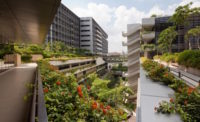Buoyed by the progress of its performance-based Living Building Challenge (LBC) green-building certification program, the International Living Future Institute (ILFI) is casting a net beyond the LBC. The Institute, through the recently-announced umbrella Living Future Challenge, says it is developing even more ways to rethink "the way humanity designs its systems, products, buildings and communities."
"It's the Living Future Institute, not the Living Building Institute, because it's not just about buildings," said Jason McLennan, ILFI's CEO. "The Living Future Challenge is a framework for remaking everything."
Toward that goal, ILFI introduced the third version of the LBC and the first version of the Living Community Challenge (LCC) at the Living Future 14 conference, held May 21-23 in Portland, Oregon. LBC is a demanding program for the production and operation of self-sustaining buildings, with a goal—among many—of net-zero annual energy use.
Version 3 "continues to push the bar forward while making the experience less challenging where it can be," said McLennan. "There is a greater emphasis on resilience—places of shelter and refuge." LCC, meanwhile, is designed to help planners and developers rethink community-scale projects. It will provide certification at both the master planning and build-out stages. The group also announced a plan to start the Living Product Challenge later this year. The goal is to change the design and manufacture of all types of products—not only building-related ones—to reduce negative environmental impact.
Both the communities and products programs were initially part of the LBC. For example, through its Red List, the LBC already restricts the specification of products that contain ingredients deemed harmful to the environment and people. Ingredient disclosure, called transparency, is contentious. Suppliers are concerned about revealing trade secrets. With the upcoming Living Product Challenge, McLennan hopes to "get beyond the distrust" between ILFI and suppliers. As far as green materials and products goes, "we are still in the Wild West," he said. "It's time for more clarity around materials and products."
Beyond that, ILFI is developing programs for living food, living enterprises, and living lifestyles. In parallel, the International Well Building Institute, separate from but collaborating with the ILFI, recently kicked off scientific peer review for the WELL Building Standard and announced that the Green Building Certification Institute will provide third-party certification. GBCI also certifies LEED buildings for the U.S. Green Building Council's rating system.
The performance-based WELL standard is a system for measuring, certifying and monitoring features that have an impact on human health and well-being, including air, water, nourishment, light, fitness and comfort, according to the WELL group, which is a for-profit Benefit Corporation. B Corps, certified by the nonprofit B Lab, meet rigorous standards of environmental performance.
Creating a WELL-certified building adds two percent or less to the cost of construction, said Paul Scialla, founder and CEO of DELOS, a provider of building wellness systems and the developer of the WELL standard. Certification costs about 75 cents per square foot, he added.
The peer review will include input from research scientists and design and medical practitioners. "We don't want to jump the gun on this without vetting all the products academically, medically, and politically," said Scialla, who started working on the standard five years ago. The group expects to release the first version by the end of the year. An accreditation program for practitioners will follow next year. The certification is designed to work in harmony with LEED, LBC, and other green building rating systems, said Scialla.
As of May 23, there were 201 LBC-registered buildings. One closely watched, registered building—expected to get the highest level of LBC certification soon—is the 50,000-square-foot Bullitt Center, in Seattle, which is 85 percent occupied. Certification cannot come until the building reaches one year of net-zero energy use at 100 percent occupancy, or some equivalent. The six-story speculative office building houses the ILFI. After a year of operation, it not only achieved net-zero energy use, it is sending an energy surplus to the local power grid, says its developer, the Bullitt Foundation.
The energy-use intensity for the first year was a 10, beating the goal of 16, said Paul Schwer, president of PAE Consulting Engineers Inc., which designed the building systems and is a tenant. A typical building has an EUI of 90, he added. "The biggest transformation for us is a deeper understanding of the impact of [electric] plug loads and how controllable they really are," said Schwer. Based on Bullitt, PAE is now advising a Fortune-500 client how to select computers to minimize plug loads. Lower plug loads mean reduced cooling needs, which can reduce a building's first cost. When the LBC was introduced in late 2006, "people thought we would never have a living building and now we have 200," said McLennan.






